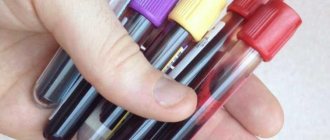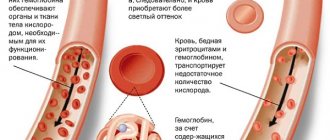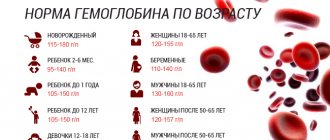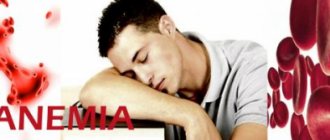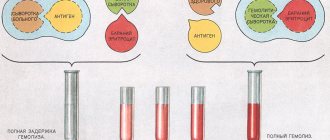Signs of pathology
Low hemoglobin brings great discomfort to the patient and causes general weakness of the body. The quality of life decreases. The following symptoms are characteristic of anemia:
- dizziness;
- constant feeling of fatigue, drowsiness;
- disturbance in heart rhythm. A person may experience both a rapid heartbeat and, conversely, a slower heart rate;
- loss of consciousness may occur;
- weakened immunity, common colds.
A decrease in hemoglobin levels may affect the temperature of the extremities. There may be a feeling of coldness in the extremities and cramps. The growth of nail plates is disrupted. During adolescence, growth slows as the disease develops. The patient's hair falls out and the skin becomes pale.
General manifestations of the disease
It is worth noting that doctors do not classify a decrease in the level of hemoglobin in the blood as a separate pathology, but the condition has a number of typical symptoms by which it can be recognized.
Naturally, detailed data on blood composition can be found from the results of a general analysis. However, not all people regularly go to the clinic for medical examinations. The following symptoms should prompt you to visit a doctor:
- regular headaches and migraines;
- feeling of general weakness;
- state of lack of sleep;
- loss of strength or fatigue;
- heart rhythm disturbances and shortness of breath;
- poor concentration and memory;
- low blood pressure;
- lack of appetite;
- disrupted menstrual cycle in women;
- problems with potency in men;
- fainting.
If you pay close attention to your health, based on the above symptoms, a person may suspect that he has low hemoglobin. Whether a blood transfusion is necessary in this case or local treatment is sufficient, only a doctor will say after a complete examination of the patient.
Causes of anemia
There are many reasons for a decrease in hemoglobin levels. The main ones include:
- Lack of iron in the human body.
- Presence of harmful parasites;
- Previous surgical operations to remove internal organs;
- Large blood loss due to injury or after donation.
- Taking medications or foods high in calcium.
- Acute stage of infectious diseases.
- Frequent stress, depression.
- Hereditary predisposition.
- Poisoning of the body with substances containing lead.
What is blood transfusion
In cases where the hemoglobin level reaches a critical point, the patient is prescribed a blood transfusion. Blood transfusion with low hemoglobin is often the only way to save the patient. In medical terminology, this procedure is called blood transfusion. The main principle of its implementation lies in two criteria.
The blood of the donor and the patient must match in terms of:
- Rh factor;
- group.
Before the procedure, the blood is thoroughly tested. The patient's blood type is compared with the donor's blood type. All compatibility is then determined using laboratory tests.
Indications for transfusion are:
- heart defects;
- large blood loss;
- detection of pulmonary or heart failure in the patient;
- the need for emergency surgery.
Procedure
How is a blood transfusion done when there is low hemoglobin? The transfusion procedure takes place in several stages:
- First of all, the doctor prescribes an examination of the patient. Finds out whether a transfusion has been previously performed to reduce the risk of complications.
- The blood type and Rh factor of the donor and the patient are checked twice. The first time the analysis is carried out in the laboratory, the second time in the hospital where the procedure is performed. Both results should be completely identical.
- Individual blood compatibility is checked by mixing drops on a glass.
- Rh factor compatibility is checked by rotating the drops in a test tube. 5. In the case of low hemoglobin, pure blood is not administered; red blood cells are used for this. The infusion rate should be small, no more than 60 drops per minute. The patient must be under strict medical supervision throughout the entire procedure. His body temperature and pulse are regularly measured.
- After 15 ml of donor red blood cells remains, the transfusion procedure is stopped. The remaining material is stored in refrigerators for two days. This is necessary in order to conduct an analysis if complications occur.
- After completion of the procedure, the patient must remain in bed for at least two hours. Over the next day he should be under the supervision of specialists. The next day, urine and blood tests are scheduled. If the urine turns brown, this indicates that complications have begun in the body.
Do premature babies have heart problems?
Anemia is a low level of red blood cells in the blood. Red blood cells are responsible for absorbing oxygen in the lungs and delivering it to other organs. A low level of red blood cells in the blood makes it difficult to transport it to other organs, and they do not receive enough oxygen. If anemia is severe, it can lead to serious health problems.
Anemia of prematurity occurs in premature infants. who were born earlier than expected.
Red blood cell production temporarily slows down in all newborns immediately after birth (especially noticeable in premature babies); Blood production does not keep up with the baby's growth; Red blood cells have a shorter lifespan in children compared to adults.
Loss of blood as a result of: Complications during childbirth; Drawing blood for testing (regular blood tests necessary to monitor the condition of premature babies); Decreased production of red blood cells as a result of the following problems: Nutritional problems; Certain infections, such as rubella or parvovirus, which affect the bone marrow (bone marrow produces red blood cells);
Family history of anemia; Complications during childbirth; Blood loss during childbirth; Diseases requiring the heart to pump a large volume of blood; Twins with feto-fetal transfusion syndrome; Poor nutrition, especially low dietary iron, vitamin B6 or B12.
Pallor; Slowness; Fast or difficult breathing; Difficulty feeding; Slow weight gain; Periods during which breathing stops.
Count the number of red blood cells; Determine how quickly red blood cells are produced; Look for signs of red blood cell destruction; Measure the level of iron and vitamin B in the blood.
The diagnosis will be made based on a blood test. Test results can also help determine the cause of anemia.
Treatment will depend on the cause of the anemia. Mild anemia may not require treatment. The doctor will simply monitor the condition of the child’s blood. Blood tests may be necessary to monitor the child's overall health so that deterioration in health can be detected early.
A common heart problem in premature babies is patent ductus arteriosus (heart disease). When a baby is in the womb, the baby's circulatory system allows oxygen-rich blood to bypass the lungs. After birth, the corresponding blood pathways close because the lungs take over the function of breathing and oxygenation.
With a heart defect, the ductus arteriosus that should have closed remains open, impairing blood circulation between the heart and lungs (Beerman 2009, Hamrick 2010, NHLBI 2009a).
If the ductus arteriosus is almost closed, leaving only a small opening, this does not pose a major problem. With a large lack of closure, the child quickly gets tired, eats poorly and slowly gains weight. Excessive stress causes the heart to stretch, causing breathing problems and affecting lung function (Beerman 2009, Hamrick 2010, NHLBI 2009b, 2009c).
Sometimes a small hole is left so that it can close on its own. While this natural process is taking place, the child may be prescribed anti-inflammatory drugs - for example, indomethacin or ibuprofen. In some cases, surgery is required to close the ductus arteriosus (Beerman 2009, Hamrick 2010).
In such a dangerous situation as hemoglobin in cancer, you should not just include iron-containing foods in your diet, but change your lifestyle to a completely healthy one.
To do this you need:
- Avoid “harmful” foods – fried, salty, smoked. Food should be simple and nutritious. In one day’s diet you need to consume all food groups - dairy, cereals, proteins, vegetables (both vegetables and fruits). Overeating should not be allowed.
- Drink at least two liters of water.
- Walk in the fresh air for at least two hours a day.
- Use moderate physical activity in accordance with the patient's condition.
- Well, and of course, give up all bad habits.
Following the principles of a healthy lifestyle for a long time helps to achieve really good results. Even if the patient’s condition is advanced, a combination of drug therapy with good nutrition, sufficient sleep, walks, and permitted exercise will help improve the quality and increase life expectancy.
The daily intake of iron is about 30 g/l, and in conditions of progressive anemia this figure increases. The menu should definitely include foods that have a high iron content.
These include:
- corn, peas, wheat, buckwheat, oats, lentils;
- celery, seaweed, spinach, vegetable juices;
- beef liver, meat, fish;
- nuts - peanuts, pistachios, cashews;
- apple, pomegranate juice;
- natural honey (in the absence of allergies);
- linseed oil.
Cereals such as oats and wheat are best consumed in sprouted form. The length of the sprout should be approximately 2 mm.
It is also important to include in your diet foods containing vitamin B and folic acid, which help in more successful absorption of iron. These are red pepper, greens, currants, rose hips, sea buckthorn
Anemic cancer patients often resort to folk remedies. And this is justified: natural products really help cope with low hemoglobin. One of these remedies is a mixture of dried apricots, prunes, raisins, nuts, honey and lemon in equal proportions. Take this healthy and very tasty dish three times a day before meals in the amount of two to three tablespoons.
A decoction of herbs can also be an effective remedy for low hemoglobin. Dried leaves of nettle, fireweed, birch, and buckwheat flowers are brewed in equal proportions. Take half a glass of the decoction about twenty minutes before meals for two months.
Normal hemoglobin levels are the key to more successful cancer treatment. Therefore, it is necessary to achieve high values of this parameter by any possible means.
- Rose hip decoction.
- Vegetables.
- Fruits.
- Cereals.
Blood transfusion for cancer
Blood transfusions for low hemoglobin in oncology are prescribed very often. It is necessary for patients who have undergone chemotherapy. Patients may experience a sharp decrease in hemoglobin levels after treatment. Given the weakened condition of the patient, emergency restoration of blood cell levels is necessary.
Indications for transfusion in oncology are:
- fast fatiguability;
- lack of air;
- severe shortness of breath at rest;
- drowsiness and malaise.
Your doctor can recommend where to get a blood transfusion if you have low hemoglobin due to cancer. Most often, the procedure is performed in specialized oncology centers. The manipulation is prescribed more than once; it can be repeated every three to four weeks. If there is severe blood loss, the procedure may need to be repeated weekly.
Who can be a donor if you have anemia?
Today there are no special restrictions regarding donation. The only exceptions are the presence of certain diseases and the absence of documents confirming the person’s identity. If this is a minor donor, then transfusion for anemia is prescribed only after the consent of parents or relatives .
The pre-procedure examination should be free of charge. In extreme cases, a donation center or hospital may require medical gloves and shoe covers. All other accessories must be free.
It is also necessary to undergo a preliminary examination, which will include a therapeutic examination, hematological and biochemical blood tests and a special test for hepatitis C and B. All research results are provided to the donor personally and this information is strictly confidential.
If you are undergoing examination in a professional clinic, you do not have to worry about the professionalism of the doctors. As a rule, large and specialized hospitals recruit responsible and qualified personnel for this position. It is also imperative to take into account the fact that disposable sets are used for transfusion. You, as a patient or donor, have every right to request some evidence of this. If you cannot be given such an opportunity, it is better to refuse the procedure. This will protect you from possible infection.
Consequences of transfusion
Like any medical procedure, blood transfusion with low hemoglobin has consequences. To increase hemoglobin levels, only red blood cells are always taken. It reduces the possibility of complications, but despite this, they can occur. Blood transfusion with low hemoglobin in women and men can cause the following consequences:
- increase in general body temperature;
- weakness, fever;
- dyspnea;
- headache;
- lowering blood pressure;
- in particularly severe cases, vomiting may occur.
If hemoglobin levels are very low, several transfusion procedures may be prescribed. In order for the effect of the procedure to last as long as possible, it is necessary to maintain a healthy lifestyle and monitor proper and balanced nutrition.
Symptoms of reduced hemoglobin
It is easy to determine the level of iron in the blood; all you need to do is take a blood test at a local clinic or diagnostic laboratory. The reason for taking the test may be an examination related to a visit to the doctor or the presence of obvious signs indicating anemia. Based on the results of the study, it will become clear which measures to restore iron in the body to prefer - iron-containing food and medications or blood transfusion to increase hemoglobin.
Strong heartbeat and difficulty breathing. Fainting and dizziness. Pain in the head, a feeling of tinnitus. Feeling of weakness and pain in the muscular system. Changes in taste and smell. Changes in the structure of the nails. Thinning, dry hair. Pale and dry mucous membranes and skin. Prolonged sluggish, apathetic state, fatigue, depression. Low blood pressure, abnormalities in the functioning of the VGT system, cold lower extremities.
If the quantitative value of iron has not decreased much, then a person may not even be aware of it. Or he begins to worry about a persistent feeling of fatigue, even after a full night's sleep, although anemia is often accompanied by insomnia.
Such sensations are caused by oxygen starvation of the body due to a lack of iron-containing protein in red blood cells in the blood or a decrease in their number or volume. After all, as you know, it is the red blood cells that are entrusted with one of the most important missions of supplying all organs, systems and tissues of the body with oxygen and the subsequent removal of carbon dioxide. Therefore, if there is a significant deviation from the norm in the hemoglobin level, it may be necessary to resort to blood transfusion to increase it.
Hemoglobin is an iron-containing protein in red blood cells, responsible for providing oxygen to all organs and tissues. It is formed in the bone marrow, bones of the skull, spine and ribs. The kidney hormone erythropoietin is responsible for controlling the sufficient production of red blood cells and, under certain conditions, triggers processes to increase or decrease the production of these blood cells.
Hemoglobin in oncology can significantly decrease or exceed the norm. Both conditions require immediate medical action, as they can lead to a decrease in life expectancy.
A decrease in hemoglobin in oncology occurs in more than half of patients (70% of cases). Cancer of the stomach and intestines causes serious forms of anemia. Low hemoglobin is also observed in cancers affecting directly or indirectly (metastasis to bone tissue) the hematopoietic organs. These include lymphoma, blood cancer, breast cancer, lung cancer and prostate cancer.
With a slight decrease in hemoglobin levels, the patient’s physical condition does not change. A drop below 100 g/l causes characteristic symptoms: weakness, dizziness, deterioration of hair and skin condition, heart and respiratory failure, and depression.
The causes of low hemoglobin in oncology are:
- Metastasis to the bone marrow leads to insufficient production of red blood cells.
- Malfunctions of the gastrointestinal tract lead to incomplete absorption of iron from food.
- Insufficient nutrition due to nausea or vomiting, loss of appetite causes a lack of proteins in the body and, consequently, the appearance of secondary anemia.
- Poisoning of the body due to the destruction of tumor tissue in the later stages of the disease.
- Chemotherapy and radiation therapy damage the bone marrow and kidneys, which leads to disruption of the hematopoietic process.
- Periodic bleeding in organs caused by tumor damage is accompanied by rapid loss of red blood cells.
Mandatory rapid stabilization of its level is explained by the following factors:
- cancer cells multiply faster under hypoxic conditions;
- oxygen deficiency leads to disruption of the functions of important body systems, which in the context of cancer gives additional negative symptoms;
- a significant decrease in hemoglobin (by more than 20%) leads to a malfunction in the body’s immune system, which undermines the body’s ability to independently fight cancer cells and other diseases (infectious, viral);
- a low hemoglobin level leads to severe weakening of the patient, which, in turn, leads to a delay in surgery or chemotherapy until this parameter is restored to adequate values.
Elevated hemoglobin is diagnosed in cancer of the liver, kidneys, adrenal glands, urinary tract and causes high fatigue, loss of appetite, insomnia, pale skin, increased viscosity and volume of blood, hypertension and blurred vision. In such conditions, life-threatening conditions can occur: heart attack, thrombosis and stroke. Exceeding normal hemoglobin levels is much less common than anemia.
How to increase hemoglobin in oncology?
There are four ways to treat anemia:
- With the help of medicines. Medicines containing iron and folic acid are used for iron deficiency conditions. The most common drugs for increasing hemoglobin in oncology are Ferretab, Ferrum-Lek, Tardiferron.
- A balanced diet or diet that includes foods high in all the necessary substances in the right amount. This method is especially suitable for patients with digestive and appetite disorders.
- The use of drugs that stimulate the production of red blood cells. This treatment is mainly used when hematopoietic organs are involved in the malignant process. The most popular drug is Eprex.
- Transfusion of blood or its components. The procedure is used if the patient suffers from internal bleeding.
How to increase hemoglobin in a cancer patient with various types of cancer? When a malignant tumor is located in the stomach or intestines, medications are used in mild cases, and in severe cases, blood transfusions are used. When treating anemia with medications, you should choose intravenous administration via a drip.
This procedure is prescribed very carefully due to its adverse effects on the cardiovascular system. If there are concomitant vascular or heart diseases, this method is contraindicated
If oncology has affected, for example, the bone marrow, then raising the hemoglobin level to normal values is not an easy task. Taking medications and changing your diet will not bring results, since in this case the process of hematopoiesis is disrupted.
To achieve the effect, two treatment methods are combined:
- blood transfusion;
- use of erythropoietin drugs.
When transfusing, it is recommended to use only isolated components of the red blood cell mass to reduce the burden on the body.
The stage of cancer also determines the method of therapy. In the first and fourth stages, treatment with iron supplements and diet is possible. The remaining stages cannot be avoided without drug treatment. Moreover, in the initial forms of oncology, therapy leads to the restoration of hemoglobin, and in the fourth stage it is supportive in nature. Transfusion is performed only when there is a balance between risk and benefit for the patient.
Regardless of the type and stage of cancer, patients need to monitor their hemoglobin levels and seek the help of specialists if they deviate from the norm. Self-medication is unacceptable. Only a doctor is able to realistically assess the patient’s health status. For prevention purposes, it is necessary to adhere to the principles of a healthy diet and take vitamins and microelements prescribed by a doctor.
Chemotherapy has a detrimental effect on the body as a whole, and causes a decrease in hemoglobin as well. Moreover, most patients have moderate and severe forms of anemia, and the effect of cancer treatment is directly proportional to the level of hemoglobin
Therefore, achieving normal levels of the latter is very important in the complex treatment of cancer.
Transfusion of red blood cells and intravenous administration of iron-containing solutions helps to achieve quick results. Other methods are not used because of the danger of harming an already weak body.
The upcoming operation requires a mandatory check of the patient's hemoglobin level. Its low quantitative characteristics reduce the effectiveness of surgical treatment by 40%. To speed up the process of normalizing hemoglobin, taking multivitamins is indicated, and in case of urgent surgery, a blood transfusion procedure is performed.
After surgery, vitamin and diet therapy is also necessary. If hemoglobin levels are life-threatening, a red blood cell transfusion is performed.
If hemoglobin is high, blood thinners are used and a diet is followed that excludes foods high in iron.
Age - newborn children have a maximum concentration of hemoglobin in the blood, which begins to decline almost immediately after birth
It is for this reason that the child’s age is indicated in the clinical blood test form for a correct assessment of the result obtained; Please note! A one-year-old child may have a hemoglobin level of 120 g/l, which is considered normal; at the same time, for a 2-3 month old baby, this indicator is a clear sign of anemia.

